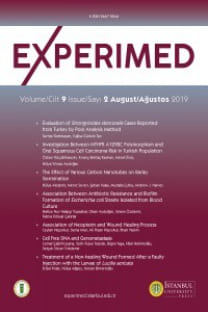Aydın ÇEVİK, Özlem TİMİRCİ KAHRAMAN, Faruk ÇELİK, Burcu ÇELİK, Gökçe ÇETİNER, H. Arzu ERGEN, Bedia ÇAKMAKOĞLU, Şakir Ümit ZEYBEK
İnflamatuar Barsak Hastalık Gelişimi Üzerinde Çevresel Faktörlerin Etkileşim Mekanizmalarının İncelenmesi
İnflamatuvar Barsak Hastalığı (IBH), çevresel, enfeksiyöz, genetik, otoimmün etkenlerden oluştuğu bildirilen bir hastalıktır. IBH' da luminal değişimlere karşı intestinal mukozanın kendini koruma yetersizliği söz konusudur ve kronik inflamasyon bu hastalığın ayırt edici özelliklerindendir. En fazla görülme yaşı, 15-25 veya 55-65 arasıdır. Adipoz doku ve elemanları birçok proteinin (adipositokin) salgılanmasını ve böylece metabolizma ve inflamasyon gibi çeşitli biyolojik fonksiyonların düzenlenmesini sağlar. Leptin öncelikli olarak spesifik hipotalamik yollardan enerji düzeylerine ve nöroendokrin fonksiyonlara etki etmektedir. Ancak leptin direnci moleküler düzeyde yeteri kadar anlaşılamamıştır. Ghrelin, ghrelin hormonu endojen reseptörünün ligandı olarak bilinmekte ve kendine özgü reseptöre bağlanarak hücre içi kalsiyum konsantrasyonlarını arttırmakta, büyüme hormonu salgılanmasına neden olmakta ve birçok fizyolojik etkisini bu yolla göstermektedir. Resistin periferik sinyal molekülü olarak tanınmakta ve inflamatuar barsak hastalığı açısından risk durumu son yıllarda araştırılmaktadır. Potansiyel letal inflamasyonda rol oynadığı bilinen sitokinlerden tümör nekroz faktörü-alfa (TNF-α)’nın etkisi insanlarda araştırılmakta ve özellikle inflamatuar barsak hastalığı patogenezinde kritik bir rol oynadığı bildirilmektedir.Epidermal growth factor (EGF), epiteliyal gelişimi, gastrik asid salınımını ve anjiyogenezi teşvik eden multipotent bir peptidtir. Bazı çalışmalarda EGF'in inflamatuar barsak hastalığında mukozanın hasara veya doku tamirine yatkınlığını etkileyen belirteçlerden biri olduğu belirtilmiştir. Araştırmamız ile panel olarak ve ilk defa bir arada çalışılacak olan leptin, ghrelin, resistin, EGF ve TNF-α belirteçlerine ait verilerin, literatürlerle uygun olarak sonuç alınmıştır.
Investigation of of Interaction Mechanisms of Enviromental Factors on Inflammatory Bowel Disease Development
Inflammatuary Bowel Disease ( IBD) is a disease reported that occurs from environmental, infectious, genetic and autoimmune factors. In IBD, there is a lack of self-protection of intestinal mucosa against luminal changes. Chronic inflammation is a hallmark of this disease. The most common age ranges are between 15-25 and 55-65. Adipose tissue and the elements of it, provides the secretion of many proteins (adipocytokines) and thus, regulation of the biologic functions like metabolism and inflammation. Leptin affects energy levels and neuroendocrine functions of spesific hypothalamic pathways primarily. But molecular means of leptin resistance is not understood enough yet. Ghrelin is known as ligand of ghrelin hormone’s endogenous receptor. It increases calcium concentrations by binding specific receptors. It leads to secretion of growth hormone and thus has many physiological effects.Recently discovered resistin, is a hormone secreted by fat cells. It is recognized as a peripheric signal molecule and the status of risk about IBD is being investigated in recent years. The effect of Tumor necrosis factor-alpha (TNF-α), known as a cytokine which is playing a role in potential lethal inflammation, is under investigation in human and it is reported that TNF-α especially plays a critical role in IBD pathogenesis. Epidermal growth factor (EGF) is a multipotent peptide that promotes epithelial growth, gastric acid secretion and angiogenesis. In some studies, EGF is indicated that it is one of the markers affecting mucosa’s susceptibility to damage and tissue repair in IBD.The data belongs to our research are corelated with the literatures. Studying of leptin, ghelin, resistin, EGF and TNF-α markers will be studied together for the first time and as a panel.
___
- 1) Jahanshahi G, Motavasel V, Rezaie A, Hashtroudi AA, Daryani NE, Abdollahi M. Alterations in antioxidant power and levels of epidermal growth factor and nitric oxide in saliva of patients with inflammatory bowel diseases. Dig Dis Sci. 2004 Nov-Dec;49(11-12):1752-7.
- 2) Oikonomou KA, Kapsoritakis AN, Kapsoritaki AI, Manolakis AC, Tsiopoulos FD, Germenis AE, Potamianos SP. Downregulation of serum epidermal growth factor in patients with inflammatory bowel disease. Is there a link with mucosal damage? Growth Factors. 2010 Dec;28(6):461-6.
- 3) Karmiris K, Koutroubakis IE, Xidakis C, Polychronaki M, Voudouri T, Kouroumalis EA.
- Circulating levels of leptin, adiponectin, resistin, and ghrelin in inflammatory bowel disease.
- Swiss Med Wkly. 2009 May 16;139(19-20):278-87.
- 4) Pache I, Rogler G, Felley C. TNF-alpha blockers in inflammatory bowel diseases: practical consensus recommendations and a user's guide. Clin Chem. 2001;47(7):1297-301.
- 5) Komatsu M, Kobayashi D, Saito K, Furuya D, Yagihashi A, Araake H, Tsuji N, Sakamaki S, Niitsu Y, Watanabe N.Tumor necrosis factor-alpha in serum of patients with inflammatory bowel disease as measured by a highly sensitive immuno-PCR. Clin Chem. 2001;47(7):1297-301.
- 6)Konstantinos Karmiris, Ioannis E. Koutroubakis, Elias A. Kouroumalis, Leptin, adiponectin, resistin, and ghrelin – Implications for inflammatory bowel disease. Mol Nutr Food Res. 2008 Aug;52(8):855-66.
- Yayın Aralığı: Yılda 3 Sayı
- Başlangıç: 2011
- Yayıncı: İstanbul Üniversitesi
Sayıdaki Diğer Makaleler
Bilge OZSAİT SELCUK, Evrim KOMURCU BAYRAK, Muhammed Abdulvahid KALKAN, Gizem ÇELEBİ, Nihan ERGİNEL ÜNALTUNA
Laboratuvar Hayvanlarında Temel Uygulamalar: Laboratuvar Hayvanlarından Kan Alma Teknikleri
Mutlu KÜÇÜK, Aydın ÇEVİK, Rivaze KALAYCI
Mehveş PODA, Filiz GÜÇLÜ GEYİK, Neslihan Çoban, Beyhan Tüysüz, Gamze Güven, Evrim Kömürcü Bayrak, Nihan Erginel Unaltuna
Aydın ÇEVİK, Özlem TİMİRCİ KAHRAMAN, Faruk ÇELİK, Burcu ÇELİK, Gökçe ÇETİNER, H. Arzu ERGEN, Bedia ÇAKMAKOĞLU, Şakir Ümit ZEYBEK
Musk-ilişkili myasthenia gravis’te antikor ve sitokin profili
Prostat Kanserinde Selenyumun Proteomik Temelli Bir Yaklaşımla Farklı Etkilerinin Belirlenmesi
